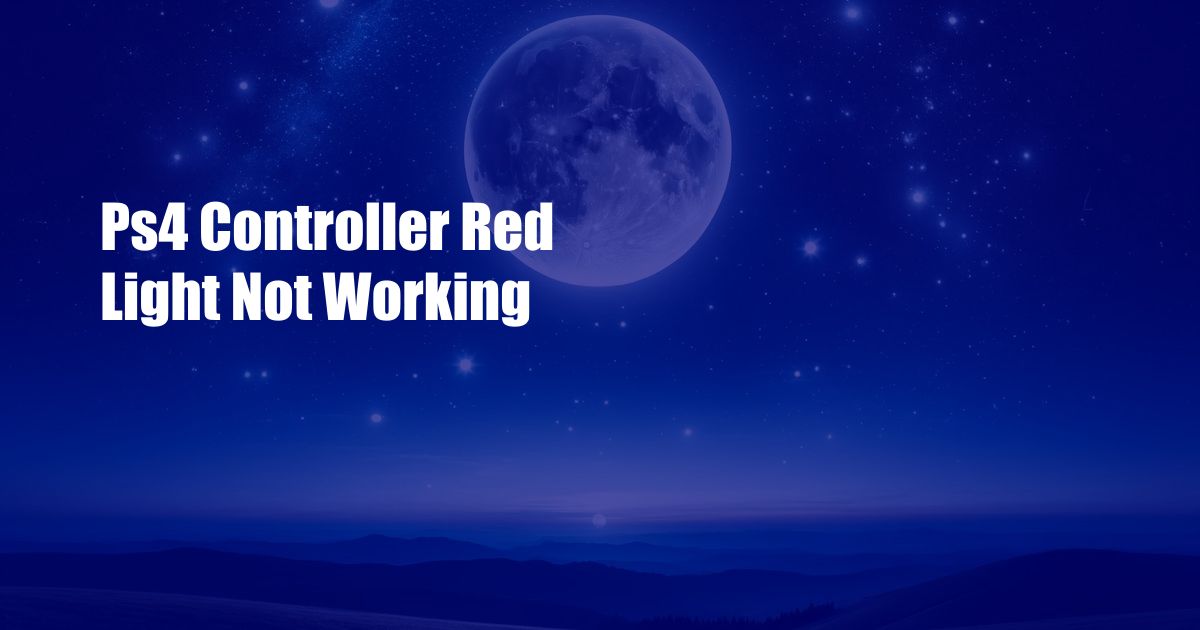
PS4 Controller Red Light Not Working: Troubleshooting and Solutions
In a recent multiplayer gaming session with my buddies, my PS4 controller’s red light abruptly stopped working, leaving me out of the game. This frustrating incident sparked my curiosity, and I delved into researching potential reasons and solutions for this common issue.
If you’re facing the same predicament with your PS4 controller, fear not! In this comprehensive guide, we’ll explore the reasons behind this malfunction and provide step-by-step troubleshooting tips to restore your controller to its former glory.
The Red Light of Controller Malfunction
The PS4 controller’s red light, typically indicating that the controller is charging, might malfunction for various reasons.
- Power issues: Insufficient power supply or faulty cables can prevent the controller from charging.
- Bluetooth connectivity: If Bluetooth is not enabled or is malfunctioning, the controller may fail to connect to the console.
- Firmware glitches: Outdated or corrupted firmware can cause the controller to misbehave.
- Hardware damage: Physical damage to the controller’s internal components can result in a red light malfunction.
- Battery problems: A depleted battery or a faulty battery connection can also lead to this issue.
Unveiling the Mystery: Troubleshooting Steps
1. Power Check: Ensure that the USB cable is firmly connected to your PS4 console and a reliable power source. Try using different cables or charging ports to rule out power-related issues.
2. Bluetooth Reconfiguration: On your PS4, navigate to “Settings” > “Devices” > “Bluetooth Devices” and forget the malfunctioning controller. Then, press and hold the PS button on the controller for 5 seconds to re-pair it. This step should resolve Bluetooth connectivity issues.
3. Firmware Update: Connect your controller to the PS4 via a USB cable and check for firmware updates. Navigate to “Settings” > “System” > “System Software Update” to download any available updates. This step ensures that the controller is running on the latest software.
4. Controller Reset: If the above steps fail to resolve the issue, try resetting the controller. Using a small tool, press the reset button located on the back of the controller for 5 seconds. This step will restore the controller to its factory settings.
5. Physical Inspection: Examine the controller for any visible damage to the charging port, buttons, or casing. If you notice any cracks, dents, or loose connections, contact Sony support or a qualified repair technician for assistance.
Expert Tips and Advice
1. Regular Cleaning: Regularly clean the charging port and USB cable to prevent dust and debris from accumulating, which can hinder charging.
2. Avoid Extreme Temperatures: Protect your controller from exposure to extreme heat or cold, as these conditions can damage the internal components.
3. Proper Storage: When not in use, store the controller in a cool, dry place to prolong its lifespan.
FAQs on PS4 Controller Red Light Issue
Q: Why does my PS4 controller’s red light blink?
A: Blinking red light indicates that the controller is in pairing mode or is experiencing a low battery.
Q: How can I fix a controller that won’t charge?
A: Try using different cables, power sources, and charging ports. If the issue persists, a hardware problem may be present.
Q: What does it mean when my PS4 controller flashes red?
A: Flashing red light typically indicates a firmware update error. You can fix this by connecting the controller to the PS4 via USB and checking for firmware updates.
Conclusion
Understanding the reasons and solutions for a PS4 controller’s red light malfunction is crucial for maintaining a seamless gaming experience. By implementing the troubleshooting tips provided in this guide, you can restore your controller to full functionality and continue enjoying your favorite games with uninterrupted fun.
We hope this article has shed light on this common issue. If you have any further questions or require additional assistance, don’t hesitate to reach out to us. Your feedback and engagement help us improve our content and provide the best possible information to our readers.

 Hovk.org Trusted Information and Education News Media
Hovk.org Trusted Information and Education News Media